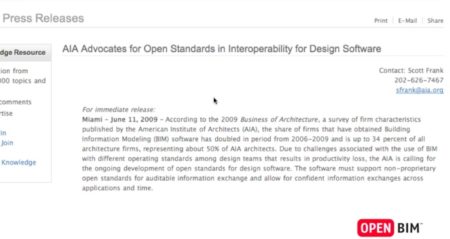Continued from page 2
The Open BIM Group
AFR: What are the exact requirements of belonging to and adopting Open BIM?
AP: Well, first of all let me repeat that Open BIM is more than an IFC interface for data exchange. Open BIM is an approach including workflow, engagement of partners and the inclusion of the entire AEC spectrum.
AFR: Why did this group of companies and organizations decide to commit to and more formalize Open BIM?
AP: What we realized is that everyone is talking about “Open BIM” but in a slightly different way. We realized that Open BIM will never get powerful enough if we are communicating in very independent ways. So we need higher level coordination.
AFR: And hence the announcement and program. That is good. Many organizations, including the AIA in the United States, have seen the need for the robust development and adoption of an open BIM standard that can have global applicability for all stakeholders in AEC. (see image 03 below on the AIA’s press release. See also this news article from Feb 2010 on the AIA’s official position.)
AP: Yes, we decided to launch this program to address these issues.

03 - This is the press release by the AIA on the need for BIM standards. The American Institute of Architects (AIA) has long seen the need for the development and adoption of an "open industry standard" for the BIM industry, so that data can be fully coordinated across multiple stakeholders outside of any proprietary data formats. The AIA believes this process is necessary for the best overall welfare of the AEC BIM industry, both in the present adoption curve of BIM and in the long term use, management and ownership of BIM data.
AFR: So who is the “we”? Who got invited or who organized this movement?
AP: It’s basically eight companies from different segments of the industry but the initial idea of formalizing an Open BIM program came from buildingSMART, GRAPHISOFT and Tekla.
AFR: So what is the orchestrated charter or mandate of this group? What’s happening now with Open BIM?
AP: There are three key things. Firstly, unified communication. Everyone in the group must use the same words and phrases in talking about Open BIM. We provide templates for group members so they can communicate about Open BIM consistently with its goals. There are now consistent standards about how to talk about Open BIM on your website and elsewhere.
Secondly, after saying things the same way we need to appear the same–that is unified. That explains the new common branding and Open BIM logo. We require each participant to use the OPEN BIM logo to help promote our common goals and commitment to a true Open BIM process.
Finally, we realized we needed to go beyond software. This includes AEC software vendors, AEC organizations and actual building projects as well. We hope people will use the new OPEN BIM logo similarly to how AEC professionals use the LEED logo is used as a sign of their commitment to sustainability.
AFR: With this broader potential for who can now support Open BIM, what would you say are the main benefits of supporting the Open BIM movement and this program?
AP: The first benefit of the Open BIM approach is that project members are free to choose tools that best fit their needs. The second benefit comes from the first one that is you are not forced to synchronized your IT cycle with others in order to keep binary compatibility–Open BIM fosters “workflow” compatibility instead.
AFR: I want to make sure readers who are thinking about BIM workflows understand this well. Can you explain this more?
AP: Yes. If you shoot for 100 percent binary compatibility like for instance it is promoted between Revit platform products then you have to ensure that everyone you need to exchange data with are on the same version of Revit. This maybe a problem if you are involved in multiple projects where a whole matrix of independent companies would need to coordinate their upgrade cycles just to keep compatibility across totally independent projects.
AFR: That actually sounds incredibly difficult and burdensome if not outright impossible.
AP: And I want to add that the final benefit of adopting Open BIM is that by adopting industry open standards like IFC you make your data open forever. As a group, like other other segments of the computer industry at larger, we are promoting the adoption of true open standards so that customer data remains truly flexible and open.
AFR: It is through open standards versus proprietary standards that data becomes your own. If all of your data lives in proprietary file formats, not matter how popular they are, the data is encased in someone else’s file format and thereby partially becomes theirs. You are dependent on a single source to access your data.
next page: Open BIM: Group Goals




Reader Comments
Comments for this story are closed